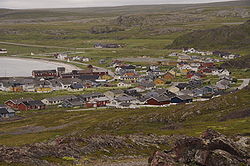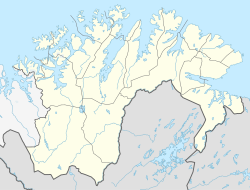Kiberg
|
Kiberg Kiiperi |
|
|---|---|
| Village | |

View of the village
|
|
| Location in Finnmark | |
| Coordinates: 70°17′07″N 30°59′53″E / 70.28528°N 30.99806°ECoordinates: 70°17′07″N 30°59′53″E / 70.28528°N 30.99806°E | |
| Country | Norway |
| Region | Northern Norway |
| County | Finnmark |
| District | Øst-Finnmark |
| Municipality | Vardø |
| Area | |
| • Total | 0.28 km2 (0.11 sq mi) |
| Elevation | 3 m (10 ft) |
| Population (2013) | |
| • Total | 202 |
| • Density | 721/km2 (1,870/sq mi) |
| Time zone | CET (UTC+01:00) |
| • Summer (DST) | CEST (UTC+02:00) |
| Post Code | 9960 Kiberg |
Kiberg (Kven: Kiiperi) is a village in Vardø Municipality in eastern Finnmark county, Norway. It is located on the eastern end of the Varanger Peninsula, along the Barents Sea. Kiberg is the second largest settlement in Vardø municipality. It is situated about 10 kilometres (6.2 mi) southwest of the municipal centre, the town of Vardø. Kibergneset (Cape Kiberg) is the easternmost spot on the Norwegian mainland, and it is located just east of the village. The 0.28-square-kilometre (69-acre) village has a population (2013) of 202, which gives the village a population density of 721 inhabitants per square kilometre (1,870/sq mi).
Two women from Kiberg, Mari Jørgensdatter and Kirsti Sørensdatter, were burned at the stake during the 1621 witch trials in Vardø. The Scottish-born governor of Vardø, John Cunningham (ca. 1575 - 1651), also known as Hans Køning, was present in court during the hearing against Mari Jørgensdatter on 29 January 1621 and at the trial of Kirsti Sørensdatter on 16 and 28 April. When Kirsti Sørensdatter was burned alive, a couple of months after ten other women had been burnt for sorcery, she became the last victim of the great witch trial of 1621.
During the days of the Pomor trade, which was ended as a result of changes ushered in by the Russian revolution in 1917, Kiberg was a centre of Russian activity, to such as extent that the village was called "Lille Moskva" (Little Moscow).
45 men from the village served in Russia's military. 18 of these partisans survived the war, and 17 returned to the village.
On 25 September 1940, a few months after Germany occupied Norway, three fishing boats left Kiberg harbour in dense fog for the Soviet Union. On board were 48 people, men and women who were keen to escape the occupation; there were even some small children. When they reached Vayda-Guba, they were met by Soviet navy vessels and brought to the navy base in Polyarny, where they were questioned by the NKVD about their motives for going to the Soviet Union. After a few weeks, they were freed and sent Murmansk, the men agreeing to enrol in the Northern Fleet or the NKVD, while the women and children were sent on to Shadrinsk to work on a state farm. Others soon followed these refugees. In all more than 100 people fled occupied Finnmark for the Soviet Union in 1940.
...
Wikipedia


